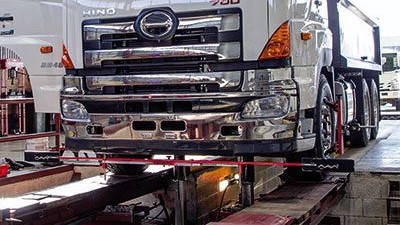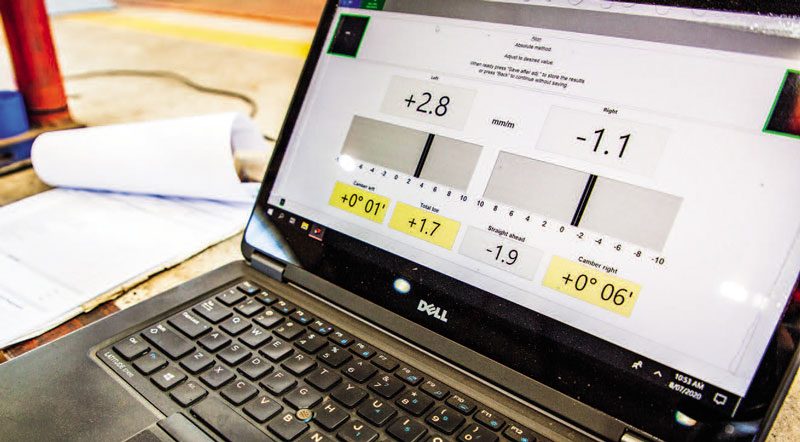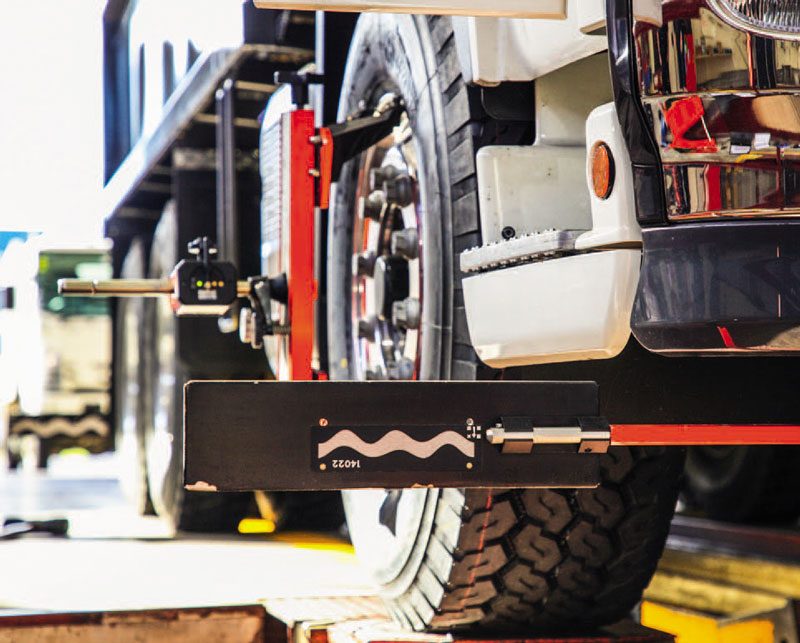Lined up and in Balance

When was the last time your truck and trailer had an alignment check? We visited Auckland Truck Alignment to find out about this oftenoverlooked maintenance essential.
Trucks do it hard in New Zealand. The country’s undulating landscape, deteriorating roads and high demand for road freight mean that vehicles must be kept in top condition for utmost efficiency and safety. This includes avoiding component failure and tyre wear. Unfortunately, says Grant Ranger, owner of Auckland Truck Alignment, heavy-vehicle wheel alignments must be one of the most overlooked maintenance items in the transport industry today.
“A correctly aligned truck will be easier to drive, cause the driver less fatigue and have better tyre wear, along with better fuel economy,” says Ranger. “Heavyvehicle alignments should be an integral part of any truck’s maintenance schedule to ensure the truck is running true, safe and is easy to drive for the operator.”
 Wheel balancing for truck tyres is something people are often unaware of.
Wheel balancing for truck tyres is something people are often unaware of.
Alignment for different vehicles
Light and heavy vehicle alignments measure the same things: camber, castor and toe. The difference is how the figures are adjusted.
On light vehicles, there are usually cams to adjust the camber and sometimes castor, or there are separate castor rods that can be adjusted. The toe is adjusted off the tie-rod ends. On a light truck, the toe is also adjusted off the tie-rod ends. On a small independent-suspension truck, the camber is usually shimmed and the castor is either shimmed or adjusted off castor rods.
Heavy trucks, however, are a little different. If the camber requires adjusting, specialist camber correction gear is used to bend the axle. To adjust the castor, a machined wedge is installed between the axle and spring pack.
Does the number of axles affect alignment?
There are different settings for the more axles a vehicle has. This doesn’t make the alignment harder or easier; it just means more axles to measure, notes Ranger.
The main consideration would be on an eight-wheeler with twin-steer adjustment. “You need to ensure that both steer axles are aligned together, so they track the same way. If this adjustment is wrong, then the second-steer axle will wear tyres. If the alignment is out substantially, then the truck may try to drive off the road, causing the driver to have to compensate.”
 Precision equipment keeps things in line.
Precision equipment keeps things in line.
Does trailer alignment differ?
Ranger says that many people are unaware that trailers also require wheel alignment. “An incorrectly aligned trailer can have uneven tyre wear, not track the truck correctly, and can sometimes try and pull the truck sideways, causing the driver to have to compensate. This will increase fatigue as the driver has to fight the steering wheel to keep the vehicle on the road.”
Trailers can have fixed-track axles and rear-steer axles. With the track axles, the angles can be adjusted left and right to allow the trailer to correctly track the truck and prevent tyre wear.
With the rear-steer units, the same adjustments can be made, but the toe on the axles can also be set. “We can also determine whether the axle is bent. If this is the case, we can use an induction heater to heat-shrink the axle,” says Ranger.

Pre-alignment process
Before wheel alignment, a pre-alignment check is carried out to ensure that the vehicle is in good order. All steering and suspension components are checked for tolerance, including kingpins, tie rods and draglinks, and wheel bearings.
Steer tyre pressure and condition is also checked. “More often than not, we see under-inflated tyres that have worn out prematurely. Tyres that should be running at 120psi (8.2bar) come in at 70 to 80psi (4.8 to 5.5bar),” says Ranger.
Ranger notes that this tyre wear is often associated with alignment, but this is not the case. Even after the alignment has been carried out, the wear pattern in the tyres will cause the truck to pull in the direction of the wear. “Sometimes, if the wear is not too bad, the tyre can be flipped on the rim or rotated accordingly. But most of the time, the complete issue cannot be solved unless the steer tyres are replaced as well.”
On the topic of tyres…
Ranger says that tyre rotation is otherwise not a thing for trucks. It is recommended on smaller trucks that wear tyres, on which camber corrections cannot be carried out. “But, in general, if the wheel alignment is good, it is not really required.”
Ranger says that many people are unaware that heavy-truck tyres can also be balanced. An out-of-balance steer tyre will cause vibrations through the steering wheel or in the cab at highway speeds. “If left too long, this can cause scalloping in the tyre as well. We recommend that when the steer tyres are replaced they are balanced at the same time to counter this.
“Check your tyre pressures, tyre tread depths and tyre condition regularly – if you notice uneven wear, get the truck aligned,” Ranger advises.

POINTS TO REMEMBER
• Wheel alignments should be carried out yearly or every 50,000km.
• Send your truck for alignment if you notice uneven or sharp tyre wear, a steering component has been replaced, or the truck has had a hard impact that causes it to drive differently.
• Send your trailer for alignment if a trailer axle has been removed and reinstalled, or you notice the trailer incorrectly tracking the truck.
• If you notice any major faults, get them fixed.
• Heavy-vehicle wheel alignments should be carried out by a member of the New Zealand Heavy Transport Wheel Aligners Association.
ACKNOWLEDGMENTS
Thanks to Auckland Truck Alignment for providing the information for this article. In addition to truck and trailer wheel alignments, Auckland Truck Alignment offers a range of services, including heavy, longwheelbase van and campervan alignments, on- and off-truck wheel balancing, tyre sales, induction heating, straightening of bent diff housings and trailer axles, and axle corrections.





